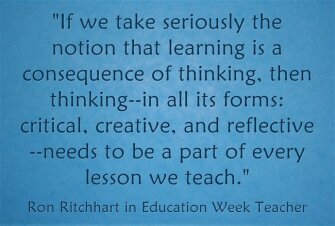I’ll begin posting new questions and answers in next week, and during the summer shared thematic posts bringing together responses on similar topics from the past four years.
Today’s theme - the nineteenth (and last) one in this summer series - is on Instructional Strategies. Though I’ve obviously published a number of new posts over the past year related to Instructional Strategies, I’ve previously added them to more “specialized” lists. So you won’t find any new ones from this year in this compilation.
Previous updated thematic collections are:
The Best Ways To Begin & End The School Year
Teaching English Language Learners
Teacher & Administrator Leadership
You can see the list of Instructional Strategies posts following this excerpt from one of them:

From 2013/14
‘Differentiation Is More Than A Set Of Strategies’
This post features a response from Kimberly Kappler Hewitt and a number of suggestions from readers.
Differentiating Lessons by ‘Content, Process, or Product’
Carol Tomlinson, Donalyn Miller and Jeff Charbonneau contribute responses.
‘Best Practices’ Are Practices That Work Best for Your Students
This post features contributions from Roxanna Elden, Barnett Berry and Pedro Noguera, along with comments from readers.
Great Teachers Focus on Connections & Relationships
Eric Jensen, Jason Flom, and PJ Caposey share their ideas.
‘Start By Matching Student Interests, Then Build From There’
Diana Laufenberg, Jeff Charbonneau, Ted Appel and special guest John Hattie share their thoughts.
The Maker Movement Can Give Students ‘A Story To Tell’
Tanya Baker from The National Writing Project discusses implications The Maker Movement has for different content areas, National Teacher of the Year Jeff Charbonneau elaborates further on its connect to STEM, and Leslie Texas and Tammy Jones make a connection to Project-Based Learning.
The Maker Movement Believes In ‘Kid Power’
Sylvia Libow Martinez and Gary S. Stager graciously adapted a portion of their book, Invent To Learn: Making, Tinkering, and Education in the Classroom, into a piece for this blog.
The Best Advice On Doing Project-Based Learning
This post is a Part Two to last year’s popular one by Suzie Boss (and readers!) on Do’s and Don’ts for Better Project-Based Learning. Suzie agreed to share additional ideas this year, as did many readers.
‘Help Students Be Organized By Being Organized Yourself’
Debbie Diller and Leslie Blauman share their thoughts, as do readers.
Practical Ideas To Help Students & Teachers Stay Organized
Three educators -- Julia Thompson, Ariel Sacks and Gini Cunningham -- contribute their responses.
The Role Of Arts Education In Schools
This post features guest responses from three educators -- Virginia McEnerney, David Booth and Heather Wolpert-Gawron.
From 2012/13
1. Using -- Not Misusing -- Ability Groups In The Classroom
This is a special guest post from author/educator Rick Wormeli.
2. Ability Grouping In Schools -- Part Two
In this post, Carol Burris, New York’s 2013 High School Principal Of The Year, and Tammy Heflebower, Vice-President of the Marzano Research Laboratory contribute their thoughts, along with comments from readers.
Educator/authors Dr. Cathy Vatterott and Bryan Harris contribute their thoughts here.
4. Do’s and Don’ts for Better Project-Based Learning
Few people know more about Project-Based Learning than Suzie Boss, and she graciously agreed to respond to this “question of the week.”
5. Assisting Students With Special Needs
Three experienced educators -- Michael Thornton, Gloria Lodato Wilson, and Ira David Socol -- offer their thoughts on the topic.
From 2011/12
1. Several Ways We Can Help Students Develop Their Creativity
This post features guest contributions from Jonah Lehrer, former staff writer for The New Yorker and author of Imagine: How Creativity Works, and from Ashley Merryman co-author of NurtureShock: New Thinking About Children.
2. Several Ways To Help Students Become Better Listeners
Middle School teacher Heather Wolpert-Gawron, author of ‘Tween Crayons and Curfews :Tips for Middle School Teachers and I share our ideas...
3. Several Ways To Teach Critical Thinking Skills
Three guests share their recommendations: Ron Ritchhart, author and researcher for Harvard’s Project Zero; educator Todd Stanley, co-author of Critical Thinking and Formative Assessments: Increasing the Rigor in Your Classroom; and Robert Swartz, Director of The National Center for Teaching Thinking.
4. Several Ways To Differentiate Instruction
I was lucky enough to get both Carol Tomlinson and Rick Wormeli to contribute their ideas here!
5. Thoughts On The Meaning Of “Rigor”
Barbara R. Blackburn, author of Rigor is NOT a Four-Letter Word; Cris Tovani, author of So...What do They Really Know?; and “Senior Provocateur” Ira Socol provide diverse guest responses, and I throw-in an intriguing chart.
6. More Ways To Differentiate Instruction -- Part Two
This post features contributions from Megan Allen, Florida’s 2010 State Teacher of the Year and Dr. Kimberly Kappler Hewitt & Daniel K. Weckstein, co-authors of Differentiation is an Expectation: A School Leader’s Guide to Building a Culture of Differentiation.
7. Several Ways To Apply Social-Emotional Learning Strategies In The Classroom
Two guests with a great deal of experience with Social Emotional Learning write responses -- Maurice J. Elias, director of the Rutgers Social-Emotional Learning Lab and Tom Roderick, the executive director of Morningside Center for Teaching Social Responsibility.
I hope you’ve found this summary useful and, again, keep those questions coming!
